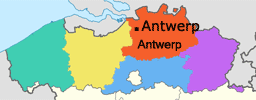 Antwerp's total population is 523,,248 as of 2018. The metropolitan area , including the outer commuter zone, covers an area of 1,449 square kilometers, with a total of more than 1,200,000 inhabitants. It is the second largest metropolitan area in Belgium, after the capital Brussels. Antwerp's total population is 523,,248 as of 2018. The metropolitan area , including the outer commuter zone, covers an area of 1,449 square kilometers, with a total of more than 1,200,000 inhabitants. It is the second largest metropolitan area in Belgium, after the capital Brussels.
According to folklore, (see the statue inf front of the town hall), the city got its name from a legend involving a mythical giant called Antigoon who lived near the river Scheldt .
He exacted a toll from those crossing the river, and for those who refused, he severed one of their hands and threw it into the river Scheldt. Eventually, the giant was slain by a young hero named Brabo , who cut off the giant's own hand and flung it into the river. Hence the name Antwerpen , from Dutch hand werpen, or throw a hand.
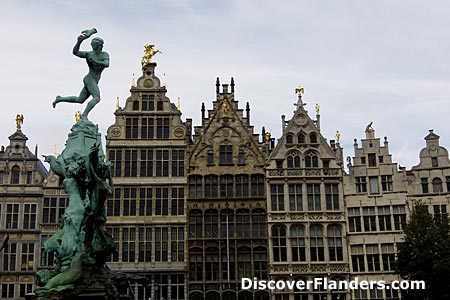 |
Statue of Brabo, on the Grand Market Square of Antwerp.
Visit picture gallery of Grand Market of Antwerp.
|
|
In the 4th century, Antwerp was first named, having been settled by the Germanic Franks. Its name then was reputed to have been derived from " anda" (at) and "werpum" (wharf).
Besides the two above explanations,, likely the name has a Roman language origin.
At the end of the 10th century, the Scheldt became the boundary of the Holy Roman Empire. Antwerp became a margraviate , a border province facing the County of Flanders in the West.
After the decline of Bruges (silting up of access to the sea), the city of Antwerp, part of the Duchy of Brabant and controlled from Brussels, gained in importance. Foreing trading missions transfered from Bruges to Antwerp at the end of the 15th century. A bit later, Antwerp reputedly became the richest city in Europe.
However, during the Eighty Years' War, in 1576, the city was plundered by Spanish soldiers, who massacred about 6,000 of its citizens. The Eighty Years' War related to religious conflicts within Europe between the emerging protestants and catholics. Antwerp was captured again by the Spanish in 1585. Many protestant citizens were allowed to leave, often northwards to the present-day Netherlands. Antwerp declined, and soon thereafter the United Provinces of the North experienced their golden age.
The city further declined for centuries and the Scheldt river was actually closed for navigation, after the Treaty of Munster (end of the 80-years war). Only at the time of Napolean the harbor was revived again.
Town Hall of Antwerp and Great Market Square of Antwerp
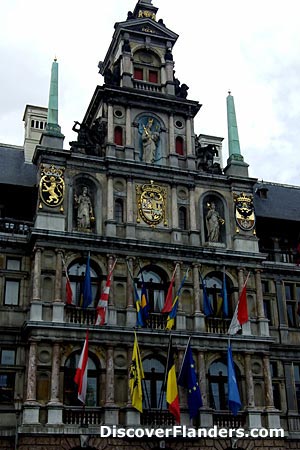 |
Facade of Town Hall of Antwerp. |
|
Replacing an older smaller building, the present Town Hall of Antwerp was built between 1561 and 1565 and Renaissance style, but needed rebuilding a few years later after being destroyed during the Spanish Fury of 1576.
The richly ornamented center section, which rises above the eaves in diminishing stages, holds female statues representing Justice , Prudence , and the Virgin Mary, and bears the coats of arms of the Duchy of Brabant , the Spanish Habsburgs, and the Margraviate of Antwerp.
As in Brussels, many guildhouses were located on the Great Market Square.
Central Station
When arriving be train, take your time to check out the impressive Antwerp Central railway station.
Cathedral of Our Lady
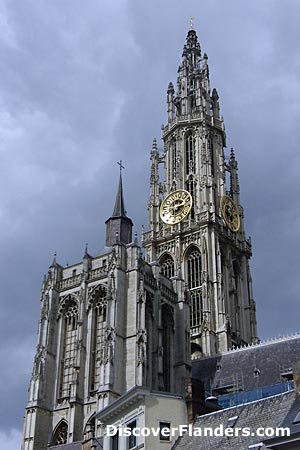 |
Cathedral of Our Lady, Antwerp.
Visit picture gallery of Cathedral of Our Lady. |
|
Still the tallest building in Antwerp (123 meters), the gothic Cathedral of Our Lady was started in 1352 with the first stage of construction ending in 1521. The cathedral houses some impressive huge paintings by P.P. Rubens, and is on the list of Unesco World Heritage sites.
P.P. Rubens works in the church include : Raising of the Cross, and, Descent from the Cross.
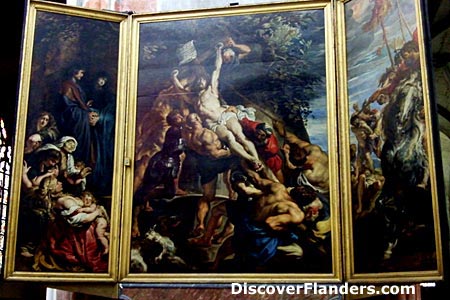 |
Raising of the Cross, by P.P. Rubens, in Cathedral of Our Lady, Antwerp. |
|
Originally two towers of equal height were planned, but the second tower never emerged. The church was also seriously damaged during the French occupation at the end of the 18th century. Over the last few decades, a lot of restoration work has been done. The Cathedral has a carillon with 49 bells.
Church of Saint Paul
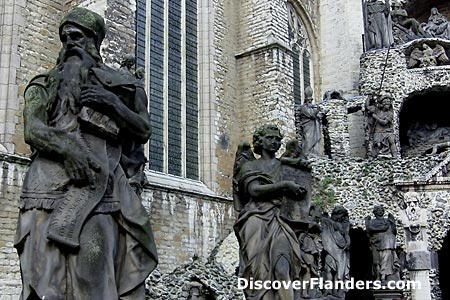 |
Calvary of rock statues, outside Church of Saint Paul, Antwerp. |
|
The Saint Paul's church was consecrated in 1571. In 1679 a new baroque tower was built after a fire. The church has been damaged extensively over the last few centuries, last by a great fire in 1968. Now however, it has been restored. The church contains a vast array of works of art, with paintings by P.P. Rubens, Van Dyck, Jordaens etc. The work by P.P. Rubens is "Adoration of the Shepherds".
In the garden next to the chuch is a Calvary, consisting of rock statues. It is something quite original and dates from 1697-1734.
Het Steen
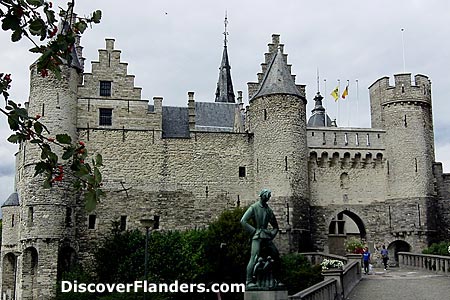 |
Het Steen, on the Scheldt River in Antwerp. |
|
For a while, Antwerp was a heavily fortified city. One remaining part of these fortifications is Het Steen (The Stone), on the banks of the River Scheldt, and within walking distance from the city center. It has now been restored. |